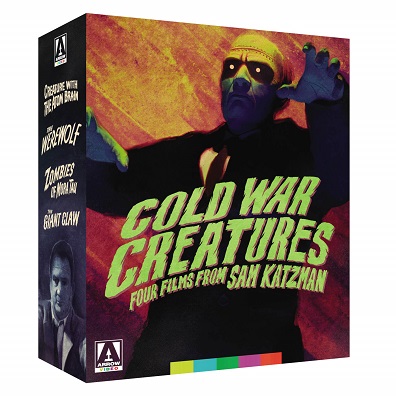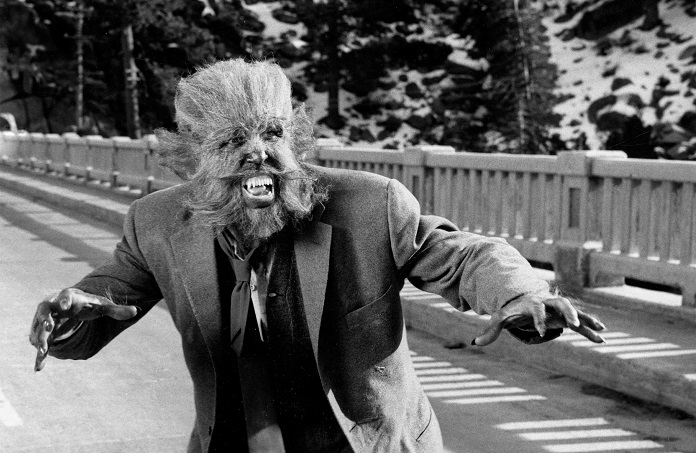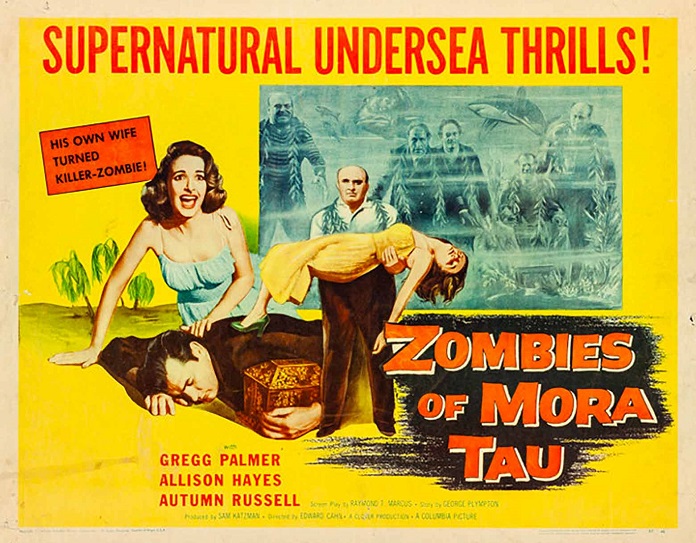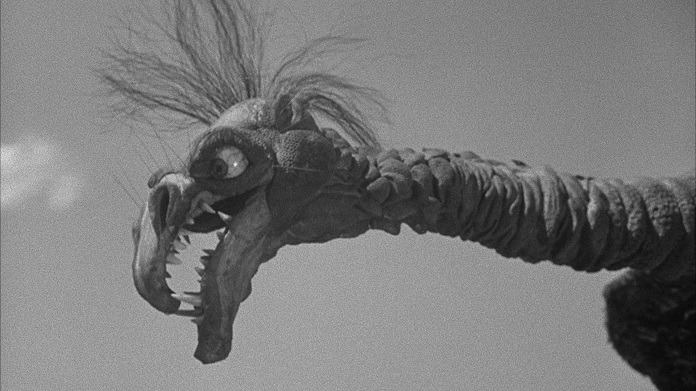
Cold War Creatures: Four Films from Sam Katzman
Studio: Arrow Video
Mar 28, 2022
Web Exclusive
![]()
One of the most prolific b-movie producers of Hollywood’s Golden Age, Sam Katzman spent his early career on Poverty Row, churning out Westerns, war films, and mobster movies at a breakneck pace. After pumping out a series of films around the East Side Kids and eight (!) movies starring Bela Lugosi in the late ’30s and early ‘40s, Katzman was scooped up by Columbia and became one of their go-to men for low-budget b-pictures. Averaging at least ten features a year, Katzman was overseeing everything from jungle adventures to the early Batman and Superman serials. Amongst all of the musicals, teen movies, and other genres he’d dip his thumb into over the course of the 1950s, some of the best-remembered are his cycle of science fiction features. Cold War Creatures, a new-ish box set from Arrow, collects four of these movies, linked together (pretty loosely) in the way that they portray Cold War fears and paranoia in the mold of old-fashioned monster movies. With their small budgets and quaint special effects, modern viewers probably aren’t going to be kept awake at night by any of the films included here, but they do manage to entertain and touch the occasional nerve. We’ll take a quick look at each below.
Creature with the Atom Brain (1955) follows Dr. Chet Walker (Richard Denning) as he helps his friend, a police captain, solve a series of bizarre murders that appear to have been perpetrated by criminals who were pronounced dead at a local hospital weeks earlier. The victims are linked by their connection to an exiled mobster and the radioactive residue found at the crime scenes. As he helps the cops and the military close in on the mobster’s laboratory hideout, Walker becomes the next target of the mad criminal, who sends his army of super-strong, radioactive zombies after him.

It would be more accurate to describe this as “Creature(s),” (plural), with the atom brains, as there are quite a few of them. The difference between these and the Romero-style zombies we’d start seeing in the following decade is that the corpses here have been reanimated for the purpose of fulfilling their master’s murderous orders, rather than to munch on the flesh of the living. Despite being a small production, the movie effectively makes it feel as if there’s a zombie crisis gripping an entire city. There’s also a very cool shot in which the villains, dressed in heavy radiation suits, crawl through a plastic tunnel to meet with their atomic monsters—and director Edward L. Cahn must have realized how cool it looked, because it’s used over and over again throughout the film. Creature with the Atom Brain is a lot of fun, if not as frightening as some of the other movies in this set.
A hapless family man is turned into a lethal lycanthrope in The Werewolf (1956), having been made the victim of two mad doctors experimenting with radiation as a form of doomsday prep. Racked with amnesia and dropped into a small town he’s never seen in his life, he changes into his half-animal form and accidentally kills a man who tries to mug him in an alley. Frightened he’ll be viewed as a monster and shot on sight, he flees into the nearby mountains and becomes the target of a massive manhunt. The local sheriff, torn between helping a troubled man and protecting his town, tries to bring him in alive with the help of local doctors; meanwhile, the mad scientists who created him are also looking for the werewolf so that they can destroy him before he can pin the blame on their unorthodox experiments.

Something like a low-budget, atomic-era spin on Dr. Jeckyll or Frankenstein, director Fred F. Sears’ The Werewolf is surprisingly effective thanks to its sympathetic man-creature. As critic Kim Newman points out in his introduction, the werewolf is the only three-dimensional character in the film: the rest are flat (but effective) archetypes, such as the lawfully good sheriff and the overly-compassionate lady doctor. Shot in an actual mountain town and the surrounding forest, The Werewolf feels quite grounded for a ‘50s monster flick. We don’t fear this particular monster as much as we fear what will happen to him.
In Zombies of Mora Tau (1957), a boatload of fortune-hunters led by a husband-and-wife seacaptain duo arrive along with their hired diver, Jeff (Gregg Palmer), and a historian, to a remote village on the African coast. In the prior century, a ship containing a chest full of stolen diamonds sank in the nearby bay; all who have attempted to recover treasure have died under gruesome circumstances. The locals speak warily of zombies—the unkillable corpses of those who’ve perished trying to possess the lost treasure. Unfortunately for our heroes, they’re not in town more than five minutes before they realize the horrifying legends are true. (But they’re not going to let that stop them from diving for the gemstones.)

Mora Tau wastes absolutely no time getting started, as one of the first things we see is a taxi driver hitting one of the monsters with his car, and then shrugging it off like it’s an everyday occurrence in these parts. In fact, the ever-presence of the zombies is probably the most frightening part of the film: the sense of dread the locals have for these things, having to be constantly vigilant because they’re always lurking nearby. They don’t seem to harm anyone who doesn’t have designs on stealing their jewels, but once they sniff greed, they’re after you, and they don’t let up—their slow-moving persistence (and imperviousness to harm) call to mind the monster from 2014’s It Follows. For a modest ‘50s b-picture, Zombies of Mora Tau has moments that are genuinely creepy; that it pulls off such a feat while featuring “underwater” scenes shot on a soundstage, with the actors moving slowly to simulate water resistance while soap bubbles rise from their diving suits, is really something to admire.
The most famous of this quartet, The Giant Claw (also 1957), has earned its place in notoriety for even hokier effects. While aiding with a radar test in the far North, pilot and civil engineer Mitch MacAfee (Jeff Morrow) spots an unidentified flying object as it speeds past his plane. Insistent on having seen something despite its not showing up on radars, several fighter jets are dispatched to investigate—all but one return having seen nothing, while the last one seems to have vanished from existence. Thus begins a series of mysterious aircraft disappearances, with seemingly little pattern and no survivors who can speak to their cause. Eventually, a weather balloon catches the perpetrator on its camera: an extraterrestrial turkey-buzzard-thing, larger than a battleship and surrounded by a shield of pure antimatter.

The Giant Claw has the feel of a Godzilla or Rodan movie, and might have been more effective if it weren’t for its hilarious monster footage. The beast looks like a foam-rubber turkey with the face of one of birdlike Skeksis from The Dark Crystal. When it strikes, it’s typically being lowered awkwardly on a string to laughably peck at models of trains and recognizable NYC landmarks. The actors *almost* manage to sell it, reacting in genuine horror to this footage. (It’s believed they were under the impression that the monster would be added by stop motion master Ray Harryhausen; instead, Katzman cut the budget down to whatever it cost its anonymous FX crew to produce this goofy puppet.) The overall effect is undeniably silly. Compared to the other three features in this set, The Giant Claw is a thick slice of b-movie cheese—which, when you’re in the mood, is far from a bad thing.
Fans of b-movie history—who are likely a significant portion of the audience interested in a box set dedicated to the work of a single producer—are going to be quite pleased with the bonus materials that were commissioned by Arrow for this release. All four films were given detailed commentaries from critics, including Russell Dyball (Creature), Lee Gambin (Werewolf), Kat Ellinger (Zombies), and Emma Westwood and Cerise Howard (Claw); these are accompanied by informative and often humorous introductions by author Kim Newman. Three of the discs include shortened Super 8 versions of the films, while all four include trailers and galleries of promotional materials. Film historian and comics artist Stephen R. Bissette provides a feature-length lecture on Sam Katzman’s career leading into his sci-fi cycle and beyond—filled with rare photos, daybills, and newspaper ads, this moves at a good clip.
Also present are several new video essays, including a piece on the women featured in these films—many of whom are much more than the simple damsels in distress that you might expect from creature features of this period—by writer Alexandra Heller-Nicholas. Josh Hurtado supplies an essay on how Katzman’s films adapted their atomic-age monsters from larger mythology; meanwhile, Mike White delves into the Cold War’s influence on how commonplace fears of the day colored these films more than the implausible, radiation-related themes they wear on their surface.
All in all, it’s another great set. Like Arrow’s previous Weird Wisconsin: The Bill Rebane Collection, the context provided by the special features is nearly as valuable as the films themselves. While the four movies only represent a very small piece of Katzman’s wildly prolific filmography, the bonus materials help paint a more expansive portrait of his impact on the film industry of the 1950s.
Current Issue

Issue #72
Apr 19, 2024 Issue #72 - The ‘90s Issue with The Cardigans and Thurston Moore
Most Recent
- Premiere: Slow Joy Releases New Single and Video for “King Cowboy” (News) —
- Hovvdy (Review) —
- Descendents, Circle Jerks @ Brooklyn Paramount, NYC, April 13, 2024 (Review) —
- Bat For Lashes Shares a Cover of Baauer’s “Home” From Her New Album (News) —
- Premiere: Veronica Lewis Shares New Single “Disconnected” (News) —

Comments
Submit your comment
There are no comments for this entry yet.